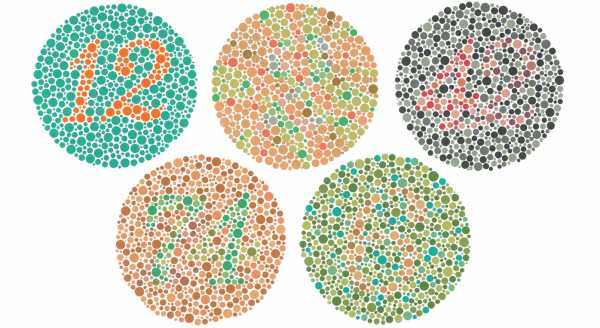What is color blindness?
Color blindness is not blindness at all, rather a condition that prevents a person from distinguishing certain colors from each other.
Color blindness most commonly occurs when the color-detecting nerve cells in the back of the eye (cones) do not respond appropriately to certain wavelengths of light that allow for color vision.
Color blindness affects:
- Over 300 million people worldwide
- 1 in 12 are male
- 1 in 200 are female
Color-blind test
Look at the images below, can you see the numbers: 12, 2, 42, 74 and 6?
If not… you may be color blind.

Find an eye doctor near you that has experience in diagnosing and providing advice for children who are color blind.
Types of color blindness
- Red-green colorblindness is the most common form, and affects dark reds and dark greens— making them appear gray/brown.
- Blue-yellow colorblindness is a more rare form, and causes blue to appear green, and yellow to appear violet.
- Achromatopsia is another rare form of colorblindness that prevents all color perception, and causes the world to appear in different shades of gray.
While colorblindness can be quite an inconvenience at times, it generally does not prevent a child from participating in daily activities, or successfully reaching developmental milestones.
An inherited condition
Colorblindness is an inherited condition that affects males more than females.
- 8% of males and less than 1% of females are color blind.
- When the mother passes the gene to her sons, they will be color blind.
Color blindness is caused by an X-linked recessive gene that a color-blind man will pass onto all his daughters. The daughter then becomes a carrier— she will not be color blind. The gene is then passed from this daughter to half of her sons.
A daughter can only be color blind when both her mother and father are color blind and pass along the gene.
This is why color blindness affects more men than women.
Symptoms of color blindness
Symptoms of color blindness are generally noticed when children begin to learn the different names of colors.
Many symptoms include:
- Confusion of certain colors or shades of colors
- Seeing green and red as gray/brown
- Using the wrong colors when coloring an object – such as purple grass
- Reduced attention for coloring worksheets
- Denial of color difficulties
- Difficulty recognizing red or green crayons
- Increased difficulty recognizing colors in dimmer lighting, smaller colored sections, and colors of the same shade
- Excellent sense of smell— often smelling food before eating
- Sensitivity to bright lights
- Difficulty reading words on colored pages, or with colored text
- Headaches after staring at red text on a green background, or reversed
- Refusal to participate in sorting or counting games with colored blocks or beads
If your child shows any signs above, contact an eye doctor near you, who can discuss the many options to help your child..
SEE RELATED: Tinted Lenses for Color Blindness
How can teachers accommodate children with color blindness?
It is important for teachers to understand the symptoms of color blindness in order to best accommodate their students.
To facilitate success in the classroom, teachers should apply the following suggestions:
- Write in black ink on a whiteboard instead of using colored ink
- Print all handouts with a high black/white contrast on white paper, not on colored paper
- Write out the names of colors if they are relevant to the lesson, such as yellow sun, blue sky, red ladybug, green grass
Is there a treatment for color blindness?
While a cure for color blindness has yet to be discovered, there are coping strategies that can help your child adapt to their color vision deficiencies, to enjoy a normal happy life. For example, encourage your child to learn to match colors with objects by memorization, teach your child to choose outfits that match by asking a parent, sibling, or friend, and help your child recognize certain items by their order rather than color such as a traffic light.
Special lenses that utilize filters to improve color perception have been designed for people with colorblindness. However, these lenses are not always effective, and can be very expensive.
LEARN MORE: Vision Therapy for Children
If you think your child might be color blind, schedule an eye exam as soon as possible.
An early diagnosis of colorblindness will enable your child to be successful in school, even with a color vision deficiency.
When color blindness is detected early, teachers can be notified and educated on how they can best accommodate their student’s learning success.


